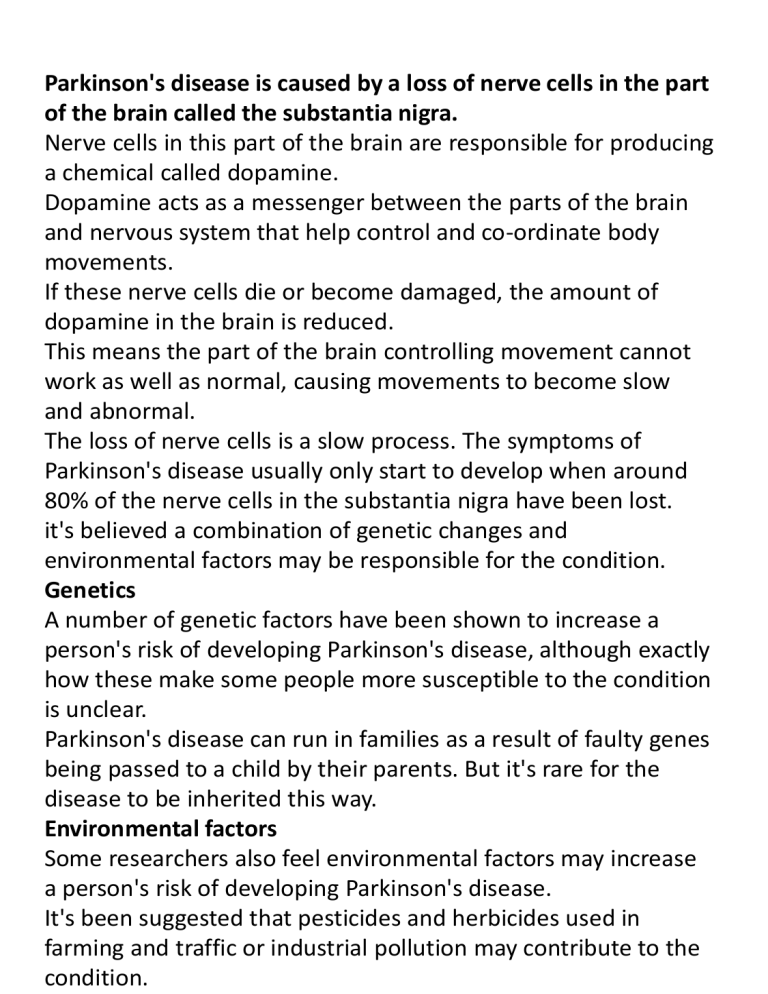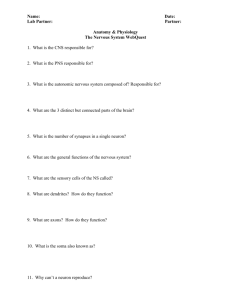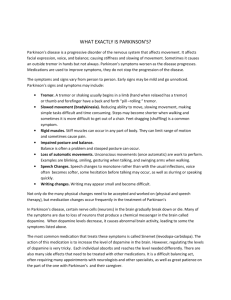Parkinson's Disease: Causes, Symptoms, and Risk Factors
advertisement

Parkinson's disease is caused by a loss of nerve cells in the part of the brain called the substantia nigra. Nerve cells in this part of the brain are responsible for producing a chemical called dopamine. Dopamine acts as a messenger between the parts of the brain and nervous system that help control and co-ordinate body movements. If these nerve cells die or become damaged, the amount of dopamine in the brain is reduced. This means the part of the brain controlling movement cannot work as well as normal, causing movements to become slow and abnormal. The loss of nerve cells is a slow process. The symptoms of Parkinson's disease usually only start to develop when around 80% of the nerve cells in the substantia nigra have been lost. it's believed a combination of genetic changes and environmental factors may be responsible for the condition. Genetics A number of genetic factors have been shown to increase a person's risk of developing Parkinson's disease, although exactly how these make some people more susceptible to the condition is unclear. Parkinson's disease can run in families as a result of faulty genes being passed to a child by their parents. But it's rare for the disease to be inherited this way. Environmental factors Some researchers also feel environmental factors may increase a person's risk of developing Parkinson's disease. It's been suggested that pesticides and herbicides used in farming and traffic or industrial pollution may contribute to the condition. Other causes include: medication (drug-induced parkinsonism) – where symptoms develop after taking certain medications, such as some types of antipsychotic medication, and usually improve once the medication is stopped other progressive brain conditions – such as progressive supranuclear palsy, multiple systems atrophy and corticobasal degeneration cerebrovascular disease – where a series of small strokes cause several parts of the brain to die Effects of parkinson’s disease Tremor. A tremor, or shaking, usually begins in a limb, often your hand or fingers. You may rub your thumb and forefinger back and forth, known as a pill-rolling tremor. Your hand may tremble when it's at rest. Slowed movement (bradykinesia). Over time, Parkinson's disease may slow your movement, making simple tasks difficult and time-consuming. Your steps may become shorter when you walk. It may be difficult to get out of a chair. You may drag your feet as you try to walk. Rigid muscles. Muscle stiffness may occur in any part of your body. The stiff muscles can be painful and limit your range of motion. Impaired posture and balance. Your posture may become stooped, or you may have balance problems as a result of Parkinson's disease. Loss of automatic movements. You may have a decreased ability to perform unconscious movements, including blinking, smiling or swinging your arms when you walk. Speech changes. You may speak softly, quickly, slur or hesitate before talking. Your speech may be more of a monotone rather than have the usual inflections. Writing changes. It may become hard to write, and your writing may appear small. Ethiopia possesses an estimated number of 6000 species of higher plants of which 10% are endemic. The country has 284 species of wild mammals and 861 species of birds. Data on other wild animals are scanty; and the number of reptile, fish, amphibian and arthropod species identified so far are 201, 200, 63 and 1,225, respectively. Of these faunal resources, 29 wild mammal, 18 bird, 10 reptile, 40 fish, 25 amphibian and seven arthropod species are endemic to Ethiopia. The country has rich resource of indigenous farm animals also. These are comprised of 28 cattle, 9 sheep, 8 goat, 7 camel, 6 donkey, 8 horse, 2 mule and 7 chicken breeds. Main direct threats to Ethiopia’s biodiversity are habitat conversion, unsustainable utilization of biodiversity resources, invasive species, replacement of local varieties and breeds, climate change and pollution. Indirect causes of biodiversity loss in the country are demographic change, poverty, and lack of awareness and coordination. Due to direct and indirect pressures, ecosystems and a number of wild plants and animals including endemic species, as well as farmers’ varieties and indigenous animal breeds are vi declining. Therefore, 103 tree and shrub species, 31 bird, one reptile, nine amphibian, two fish and 14 other invertebrate species are threatened. Ethiopia is a centre of origin for many cultivated plants such as Tef (Eragrostis tef), noug (Guizotia abyssinica), Ethiopian mustard (Brassica carinata), enset (Ensete ventricosum), anchote (Coccinia abyssinica) and coffee (Coffea arabica). The country is also a centre of diversity for species such as wheat (Triticum sp.), barley (Hordeum vulgare), sorghum (Sorghum bicolor), pea (Pisum sativum), cowpea (Vigna unguiculata), chickpea (Cicer arietinum), lentil (Lens culinaris), chat (Catha edulis), shinyleaf buckthorn (Rhamnus prinoides), cotton (Gossypium herbacieum), castor bean (Ricinus communis), oats (Avena abyssinica) and clovers (Trifolium sp.). Wild relatives also exist for In Ethiopia, some institutions have so far identified limited number of microbial species out of which 381 species of bacteria, fungi and microalgae have been conserved in national gene bank.





